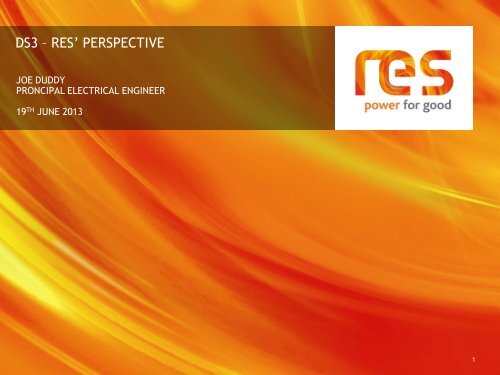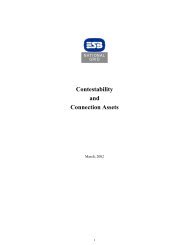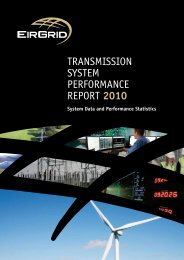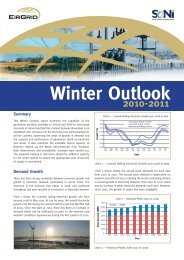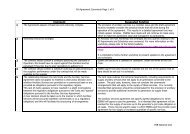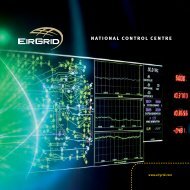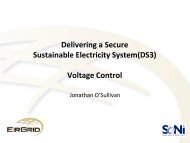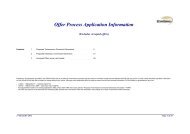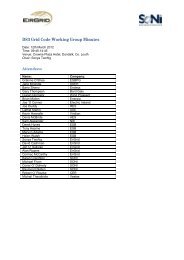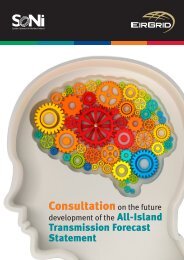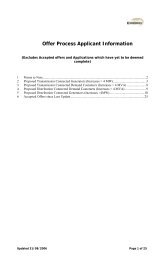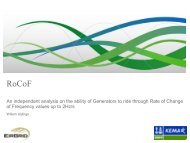RES Presentation - Eirgrid
RES Presentation - Eirgrid
RES Presentation - Eirgrid
Create successful ePaper yourself
Turn your PDF publications into a flip-book with our unique Google optimized e-Paper software.
DS3 – <strong>RES</strong>’ PERSPECTIVEJOE DUDDYPRONCIPAL ELECTRICAL ENGINEER19 TH JUNE 20131
<strong>RES</strong> OFFICES WORLDWIDEUK & IRELANDHQ – Kings LangleyBristolGatesheadGrimsbyLarne (NI)GlasgowEast KilbrideCardiffFRANCEAvignonLyonParisBordeauxTURKEYIstanbulUSAAustin, TexasBroomfield, ColoradoMinneapolis, MinnesotaPortland, OregonCANADAMontrealAUSTRALIASydneySOUTH AFRICACape TownSWEDENGothenburgOstersund<strong>RES</strong> employs around 1000 staff in 22 offices across the world
<strong>RES</strong> GROUP PORTFOLIO TO DATE• >6.9 GW wind energy capacity completed worldwide in over 100 projects• <strong>RES</strong> portfolio would power the equivalent of 4 million homes• Carbon savings through <strong>RES</strong> projects would take 5 million cars off the roads• Several thousand MW in development or construction across 9 countries• Offshore wind development in France, UK & Ireland, and N America• Ownership interests in operating projects: 700+MW4
<strong>RES</strong>’ PORTFOLIO IN IRELAND• All island capacity– 241MW constructed– 132MW owned or operated by <strong>RES</strong>• Northern Ireland– 14 wind farms constructed– 62MW with planning permission, not yet constructed– 55MW of planning applications– Partner in First Flight Wind 600MW offshore wind farm development• Ireland– 4 wind farms constructed5
<strong>RES</strong> INTE<strong>RES</strong>T IN DS3Pioneering Ireland• Ireland pioneered grid code requirements for wind• Highest wind penetration now• One of the highest wind penetrations in future• DS3 is tackling problems today which others will face tomorrow6
THE PERFECT TRANSMISSION SYSTEMFrom a wind farmer’s point of view• Adequate capacity to transport wind generation at all times– Free from constraints– Allows operation of a perfect market– Interconnected to neighbouring markets• Facilitates connecting users• Stable– Accessible– reasonable and predictable costs for connection and use– reasonable program for new connections– Free from disruption– Has access to and adequately remunerates all required ancillary / balancingservices7
RELATED GB ACTIVITY• Frequency Response Technical Workgroup (Inertia)• High Wind Speed Shutdown Workgroup• Frequency Changes during Large Disturbances and their Impact on theTotal System Workgroup (RoCoF)• Electricity Market Reform (Capacity Mechanism)8
FREQUENCY <strong>RES</strong>PONSE TECHNICAL WORKGROUPhttp://www.nationalgrid.com/uk/Electricity/Codes/gridcode/workinggroups/freqrespTSG/• Reported 15 th November 2011 and concluded that• New frequency response services would be required in response to– Increases in renewable generation, potentially exceeding minimum demand– Anticipated increase in largest loss of infeed from 1320MW to 1800MW• Inertia will reduce and RoCOF will increase• On loss of infeed, fast frequency response can be as effective as inertiain arresting the frequency nadir• System frequency management with large penetration of asynchronoussources and can only be achieved if they provide the above services• Wind turbine fast frequency response has some advantages over syntheticinertia• Recommended further consideration of RoCoF challenges9
HIGH WIND SPEED SHUTDOWN WORKGROUP• Reporting soon• Preliminary conclusions– No changes are required to GB Grid Code– Wind generators should provide the TSO with data after actualevents using existing grid code provisions– OC7 Operational Liaison– OC10 Event Information Supply– National Grid to use above data to improve its modelling of HWSSrisk– GB GCRP to review after 2 years10
FREQUENCY CHANGES ... WORKGROUPReporting soon• Studied projections of renewable energy, inertia and RoCoF• Considered the risks of multiple embedded generator disconnectionswhich would occur as system RoCoF increases beyond existing islandprotection trip settings• Considered mitigation methods including– The costs of present actions to increase inertia and minimise loss ofinfeed risk– The costs of constraining on additional frequency responsive generators– the risks to DNOs and Users of desensitising RoCoF protection forgenerators >5MW• Recommending that all new generators should withstand 1Hz/s• Commissioned risk assessment study which shows acceptable risk forchanging RoCoF protection settings on 5-50MW generators to 1Hz/s11
ANCILLARY SERVICES• National Grid has issued three rounds of requests for tenders to provideovernight– Voltage management (selected zones)– Inertia (all zones)• National Grid’s Balancing Services Standing Group (BSSG) andCommercial Balancing Services Group (CBSG) are considering a mandatory5 second “Rapid Frequency Response” (RFR) requirement which may berequired during periods of low demand and high asynchronous generation.– Various procurement options are being considered.– Primary response in GB is normally delivered in 10 seconds12
THE FUTURE• DS3 envisages a world where 2020 targets are met and asynchronous sourcesmeet up to 75% of demand with “only” 5% of wind energy constrained• Marginal price of the above 5% could attract novel users• Post 2020 opportunities and methods for further increasing renewableenergy• Some developers looking to build wind capacity and export to GB withoutinterconnection to the Irish system. Could this be a lost opportunity?13


